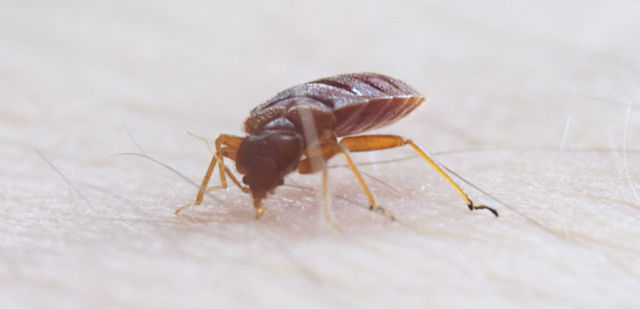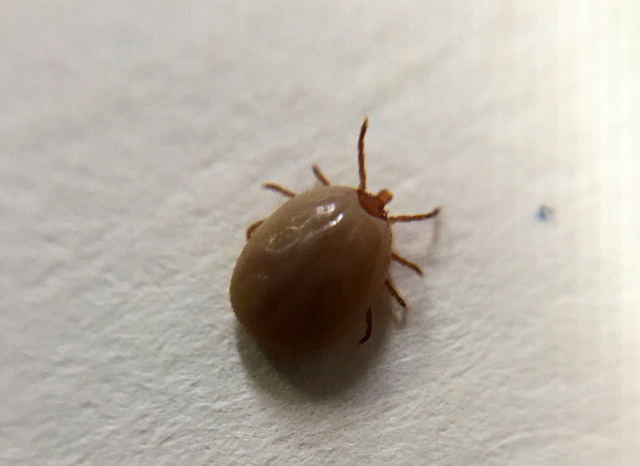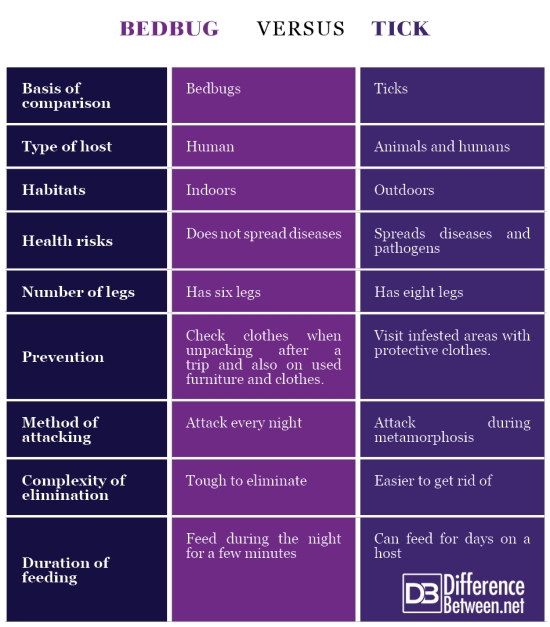Difference Between Bedbug and Tick
Bedbugs and ticks are parasites; they depend on their hosts for survival. In most cases, hosts are not harmed by parasites; the relationship is usually neutral. However, this is not the case with bedbugs and ticks. Bugs and ticks cause adverse effects on their host. If not dealt with instantly in extreme cases, these effects can lead to death.
There are two main categories of parasites, ectoparasites and endoparasites. Ectoparasites refer to parasites that are found outside the body of a host. Since they live on the skin, they cause itchy skin, bumps and rashes. Bedbugs and ticks are in this category of parasites. Endoparasites are parasites found inside the body for example in the brain or blood system. Examples of other endoparasites are tapeworms and flatworms.
What is a Bedbug?
A bedbug is a brown, flat and oval-shaped blood-sucking parasite; it is mostly likened to an apple seed. They belong to a specific family of insect known as Cimicidae. There are several species of bedbugs; however, Cimex lectularius and Cimex hemipterus, are the most common species that infest humans.
Bedbugs live on the cracks of beds, bed frames and headboards. They live on the bedside because they usually feed on humans when they are asleep. Their bites are painless hence the attacked person notices the attack way later. The bitten skin turns red and has a darker spot in the middle. They are known to bite the neck, hands, arms and face of a human. In some people, the bites cause allergic reactions, for instance, severe itching. Bedbugs do not, however, transmit or spread any human diseases. Bedbugs are tough to get rid of since their population grows fast. It is therefore advisable to invest in a professional pest controller once you detect their presence.
What Is a Tick?
A tick is a tiny and wingless parasite. It belongs to the Arachnid class. There are various types of ticks for instance cattle tick, American deer tick and sheep tick. There are three families that ticks can be classified into:
• Ixodidae (hard ticks)
• Argasidae (soft ticks)
• Nuttalliellidae
Ticks mostly thrive in areas that are warm and humid. For metamorphosis to take place, they need air that is moisturized at a certain percentage. Ticks stay at the end of leaves of both plants and shrubs as they wait for their hosts. Once the hosts come to feed, the ticks drop on them.
The tick bites cause bumps and itching on the host due to the anticoagulant. Since ticks cannot jump or fly they usually crawl around. Using their legs, they can detect changes in the host’s skin using a sensory organ called Haller’s organ.
Ticks are dangerous because they quickly spread diseases to the host since they feed on multiple hosts during their lifecycle.
Differences Between a Bedbug and a Tick
1) Type of host
Bedbugs feed on human only while the tick feeds on both human and animals.
2) Habitats
Bedbugs are found in the indoor environment, on the other hand, ticks live outdoors.
3) Health risks
Bedbugs only cause bumps and itches without spreading any disease. Ticks feed on different hosts hence spread infections like tularemia and Lyme disease.
4) Number of legs
Bedbugs are insects they, therefore, have six legs. On the other hand, ticks are arachnids like the spiders and therefore have eight legs.
5) Prevention
To prevent bedbugs, you need to be cautious when unpacking before, after and during a trip. You also need to check for bedbugs in used furniture and clothing before taking them home. For tick infestation prevention you need to avoid going to tick-infested areas. Wear protective clothing if you must go to the infested areas.
6) Method of attacking
Ticks only feed on a host and then drop till next metamorphosis while bedbugs feed on the human every night.
7) Complexity of elimination
Bedbugs are tough to get rid of because they hide in dark areas that are hard to see and they attack you at night. Ticks, however, can be seen crawling on you making it easier to eliminate them. You also got an option of wearing protective clothing when visiting infested areas.
8) Duration of feeding
Bedbugs are clever creatures they know that you can pick them off, they therefore only feed for a few minutes and get back to their hiding areas. Ticks, however, can feed for days on the host before dropping from them.
Bedbug vs. Tick : Comparison Table
Summary of Bedbug vs. Tick
- Both bedbugs and ticks are ectoparasites.
- Bedbugs are insects and ticks are arachnids.
- Both bedbugs and ticks cause harm to their hosts which can at times be fatal.
- Bedbugs and ticks can both be prevented through proper adherence to safety measures.
- Though both bedbugs and ticks cause harm to a host, only ticks can spread diseases.
- Bedbugs only feed at night while ticks mainly feed during the day.
- Difference Between S Corp and C Corp - September 9, 2018
- Difference Between Terrace and Balcony - September 9, 2018
- Difference Between Anabaptists and Evangelicals - August 31, 2018
Search DifferenceBetween.net :
Leave a Response
References :
[0]Image credit: https://www.flickr.com/photos/niaid/33224393243
[1]Image credit: https://upload.wikimedia.org/wikipedia/commons/thumb/6/6b/Bedbug002.jpg/640px-Bedbug002.jpg
[2]Allen Frost & Aaron Gunderson (2017). The Book of Ticks Paperback
[3]Jeff Eisenberg (2011). The Bed Bug Survival Guide: The Only Book You Need to Eliminate or Avoid This Pest Now Paperback
[4]Ben H. Winters (2011) Bedbugs: A Novel of Infestation Paperback



